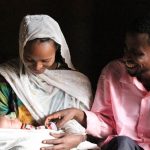The Dilemma of Men’s Participation in Reproductive and Family Health

Everywhere in the world, life is more difficult for women than men. The difference between men’s and women’s lives in low and mid-income countries (LMIC) is a source of concern for those working to achieve global justice. Women in LMIC often have limited abilities to make decisions regarding their jobs, their health (particularly their reproductive health), and their participation in public life. Why is that?
Part of the answer can be found using social norms theory. Social norms are the informal rules of behavior that dictate what is acceptable within a given social context. Gender-related social norms are often deeply ingrained within the cultural framework of a society and embedded in its institutions. They are taught, modeled and reinforced since children are very young. In strongly patriarchal societies, gender norms for women might include expectations of submissiveness, duty to family above duty to self, strong expectations of motherhood, strictly monitored sexual fidelity, limited mobility, and modesty in physical appearance and behavior. These expectations can also limit women’s access to resources and services. The result is often a disproportionate distribution of power, with men (some deliberately while other possibly unconsciously) enjoying greater decision making over personal and family life.
Given this unequal distribution of power, many practitioners wonder whether men should be part of international development programs that aim to improve women’s lives. So far, the trend has been, in general, towards working only with women partly because programmatic theories of behavior change often consider women as independent behavioral agents. Interventions to promote contraceptive use, for instance, often work only with women to help them overcome local structural and social barriers that limit their access to services and resources. Some of these interventions, however, resulted in generating more harm than help for women. That is because on some occasions, women were empowered to resist existing social expectations, but there are no efforts made to change those expectations at the level of the social context in which those women lived. As a result, women would stand up for their rights, but the people around them, including husbands and in-laws, would not understand their arguments or would see them as a threat to their authority, responding with increased control and dominance. As awareness of this problem has increased, programmatic efforts have experimented with including men particularly in the discussions around family health.
This problem, however, leaves us with what seems to be an unsolvable dilemma. Do programs that target men in attempts to help women end up reinforcing of challenging the unequal status quo? Do these programs, in other words, end up helping men and women live together more equitably, or do they increase the unequal distribution of power by including men? In some contexts, despite unequal gender norms, women still manage to make some decisions about their own bodies and their own health, as those decisions can be considered “women’s business.” Offering men more resources or decision making power might disempower women who were autonomously making decisions until their husbands were drawn into the process. On the other hand, recent empirical research has shown that when men are positively engaged in the process of pregnancy and childbirth, the women and babies are likely to have better health overall. Men who are present at birth and actively interact with newborns have elevated oxytocin levels, and lower levels of testosterone, which can help men forge stronger bonds with their children. Men’s engagement has also been found to be linked to their increased participation in childcare later on, an important factor to increase both women’s agency and men’s healthy relationships with their children and families.
To achieve positive men’s participation, however, takes more than talking to men to convince them of the need to be there for their wives. A man’s role in the family is not only shaped by what the man wants to do. He also needs to think about what his wife, family, friends, and neighbors expect from him. That is, for men to be actively engaged in women’s and children’s reproductive health, social expectations around men’s role in their context must also change. Encouraging men to help their pregnant wives with heavy housework is a worthy goal, but unlikely to success if the men who attempt those behaviors are ridiculed by other men in their social surroundings. Similarly, men who may want to do more child care work in the family might be strongly chastised by friends or family members, their own mothers for example, who might insist that it is women’s job to take care of children, not men’s. Without changing deeper gender specific social norms, efforts at change along the surface might eventually fail.
Holly adds this anecdote: When traveling through rural Honduras to understand decision making around childbirth, our team visited an indigenous village. The woman who was our guide warned us as we entered the village that it was considered a “problem village” because the people there didn’t follow the health recommendations of the health promoters, including the fact that most births took place at home. We discovered, as we talked to people in this village, that most of the births took place at home with the assistance of one local midwife. Intrigued by this, we sought out this woman and spent some time talking to her. One of the most interesting she told us was how she had a policy, a very strict policy, of requiring participation of the father at the birth. This she believed, was his responsibility, and the men in the village, understanding that expectation, complied accordingly. Later when we talked to one of those men, he relayed his experiences. He and his wife had 7 children, and he had been present and assisted at every birth. The most compelling thing about his story was the confidence he had around the process of childbirth, the care of infants and of young children, and his belief about the positive role of fathers in the process. The men in other villages, where births took place at a maternal health clinic which did not allow men in the birthing room, were disengaged from the process and considered it something in which they did not expect to participate.
Ben had a similar experience: I lived for an extended period of time in a village in rural West Africa, where I studied social norms regulating appropriate behaviors for men and women. One day, as I was talking with a young man, this man’s wife called to ask whether she could go to the clinic. He said she needed to wait for him to return home and they would go together. This man explained to men that, in his opinion, frankly there was no real problem in his wife going alone: she could walk to the clinic, the road was safe, and she would have been back in time to take care of the children. “Why did you tell her to wait?” I asked. Well, said this man, it’s ok with me, but if others see my wife walking alone they might think I am being cheated on: “around here people think that when women leave the household they are looking for troubles.” This man, in other words, was open to the possibility of his wife leaving the household, but was worried about the deeper set of beliefs that structured social life in his village. A change in behavior required effective collective renegotiation of those beliefs with other men and women in the village, not just convincing people individually of the advantages of having women visit the clinics autonomously whenever they needed.
“We wait until the placenta is delivered before we tell the mother the sex of the baby. If it is a girl she may have a stress response in her body or feel scared of the response of her husband and mother-in-law. It could make delivering the placenta very difficult.” – Nurse Mentor, Faizabad, Uttar Pradesh
Just moments before, a small, shriveled infant had emerged into the world and taken its first breath. From the side of the room, I could see the mother lying on the table, still gritting her teeth and gripping the rusted metal edges of the platform. The mother’s life-blood still pulsed through the membranous purple umbilical cord for a moment until it was clamped and cut with a clean blade. These two beings who had been independent for nine months became separate humans. A cloth was wrapped around the baby’s lower half, hiding the genitalia, while mucus was suctioned from the nose and its weight was recorded. The placenta came easily. When I was a medical student assisting with deliveries, I always felt awe at the magic of birth and the humility before this new life, seemingly full of potential and with many experiences ahead. Certainly here, especially if the baby was a girl, her life would be shaped by challenges and discrimination. We left the room to give the mother and her family some space. I never found out the sex of the baby
I am currently a resident Family Medicine physician in Seattle with a strong connection to South Asia. I lived in rural Nepal for a year studying community health, participated in hepatitis B research in Ladakh, India, and several photo projects in the region. One of my main goals as a primary care doctor is to address social inequities that impact health, including those related to gender, particularly through a global public health lens.
The web of son preference, gender discrimination against girls, and violence against women is visible everywhere in India. it is especially severe in Uttar Pradesh (UP) – 36.7% of women have experienced spousal violence, compared to 28.8% nationally and the sex ratio is 878 girls for every 1,000 boys. In Summer 2016, I spent a couple of weeks int he state, learning from two thoughtful and impactful organizations, Sambodhi and Population Council.
There is evidence that demonstrates the links across traditional masculinity norms, son preference and intimate partner violence (IPV). A large study in UP interviewed over 9,000 men and 3,000 women and reported that the average India man is “convinced that masculinity is about acting tough, freely exercising his privilege to lay down the rules in personal relationships, and above all, controlling women.” This study reported some of the highest prevalence of IPV of 75% with 30% of men reporting perpetuating sexual violence in the past year compared to 7-15% in other states. The study also shows that 60% of respondent men admitted to using violence to assert their dominance over their partner if she was unable to bear on a son. Another study, by the UNFPA, found that close to 50% of men and 43% of women preferred a son, and showed discrimination against daughters.
During my time in Uttar Pradesh, I interview Auxiliary Nurse Midwives (ANMs), Accredited Social Health Activists (ASHA’s or female community health mobilizers), and Anganwadi (rural child care centers, teaching and providing food for children under six) workers. I also learned about the gender equity research projects and monitoring the plans that the United States, are locally run by educated and motivated Indians who understand complex cultural dynamics, government function, and the way to best gather data on sensitive and taboo topics.
When I worked in Far Western Nepal, I witnessed similar trends in son preference and intimate partner violence. I remember drawing a poster to be used for education during village health fairs. It demonstrated how women contribute the “X” chromosome to the fetus and men contribute either “X” or “Y”, which determined the child’s biological sex. The poster aimed to alleviate the burden of violence and same towards mothers who gave birth to a girl, and to illuminate the role that the man’s sperm plays in the ultimate sex determination. In Nepal, the sex ratio at birth is 934 girls for every 1,000 men. These data are before the effects of infanticide and death from neglect are seen.
Factors that drive son preference weave through layers of culture, history, and economics. Men and women in Uttar Pradesh agree that the most important reasons for having a son are to carry on the family name and to provide support to parents in their old age. Dr. Kumudha Aruldas, Senior Program Officer for Population Council, affirmed that “families feel the economic burden of raising a girl who will ultimately move into her husband’s house and contribute to domestic duties under her husband and new mother-in-law.” In Hindu tradition, sons are also needed to perform certain religious functions, including lighting the funeral pyre to cremate deceased parents. Additionally, girls are considered an economic liability with the dowry system and the high cost of weddings.
Gender inequity infiltrated in to pregnancy, delivery experience, and subsequent treatment of girl children. Although the steps towards cultivating gender equity are overwhelming, research highlights spaces of hope and success. For example, the Center on Gender Equity and Health’s (GEH) research project Counseling Husbands to Achieve Reproductive Health and Marriage Equity (CHARM) study found that including men in gender equity-focused family planning counseling supported improved contraceptive communication and use among married couples, as well as decreased marital sexual violence. There will also be work to do reaching out to boys and teaching alternative ideas of masculinity in schools and the home, and ensuring quality education for both sexes, which is shown to reduce violence and discrimination against girls and women. Additionally, it will be important to ensure women’s access to income.
During my time in India, I was humbled and inspired by the creativity and dedication that I saw from the people at Population Council and Sambodhi. They are sharp, respectful, and motivated to cultivate real and sustainable change women for in India. I left energized with insights that I know will impact my work as a Family Medicine physician focused on community health, social justice, and health equity. I left with hope for tiny, cloth-bound infant held in its mother’s arms, after meeting so many health providers and researchers in India dedicated to reducing gender inequities and improving treatment of mother and the survival of all children, girls and boys.
Authored by: Holly B. Shakya, PhD & Beniamino Cislaghi
References:
- International Institute for Population Sciences (IIPS) and Macro International. 2007. National Family Health Survey (NFHS-3), 2005-06: India: Volume II. Mumbai: IIPS.
- Oldenburg, Philip. “Sex Ratio, Son Preference and Violence in India: A Research Note.” Economic and Political Weekly, vol. 27, no. 49/50, 1992. pp. 2657-2662.
- Nanda P, Guatam A, Verma R, Khanna A, Khan N, Brahme D, Boyle S, Kumar S (2014). “Study of Masculinity, Intimate Partner Violence and Son Preference in India.” New Delhi, International Center for Research on Women (Available at: www.icrw.org; inida.unfpa.org) 2 Cnesus 2011, Office of Regist
- “Nepal.” The World Factbook. Central Intelligence Agency, 2017. Web. 14 June 2017.
- Sunita Kishor. “Gender differntials in child mortality: A review of the evidence”. in Monica Das Gupta., Lincoln C. Chen and T. N. Krishnan (005.), Women’s Health in India: Risk and Vulnerability (Bombay: Oxford University Press, 1995), pp. 19-54.
- Raj A, Ghule M, Ritter J, Battala M, Ganjanan V, Nair S, et al. Cluster Randomized Controlled Trial Evaluation of a Gender Equity and Family Planning Intervention for Married Men and Couples in Rural India. PLoS ONE 2015; 11(5)



